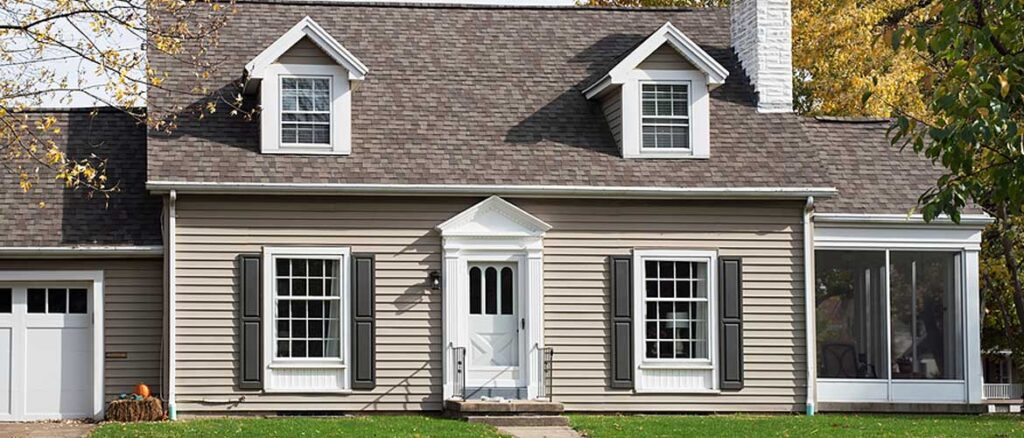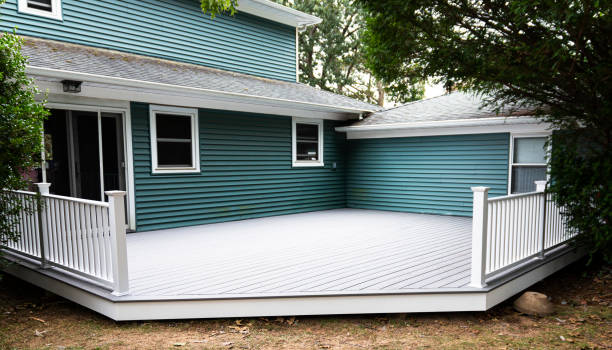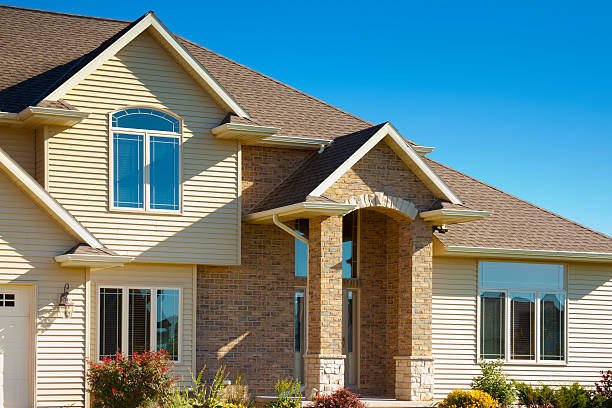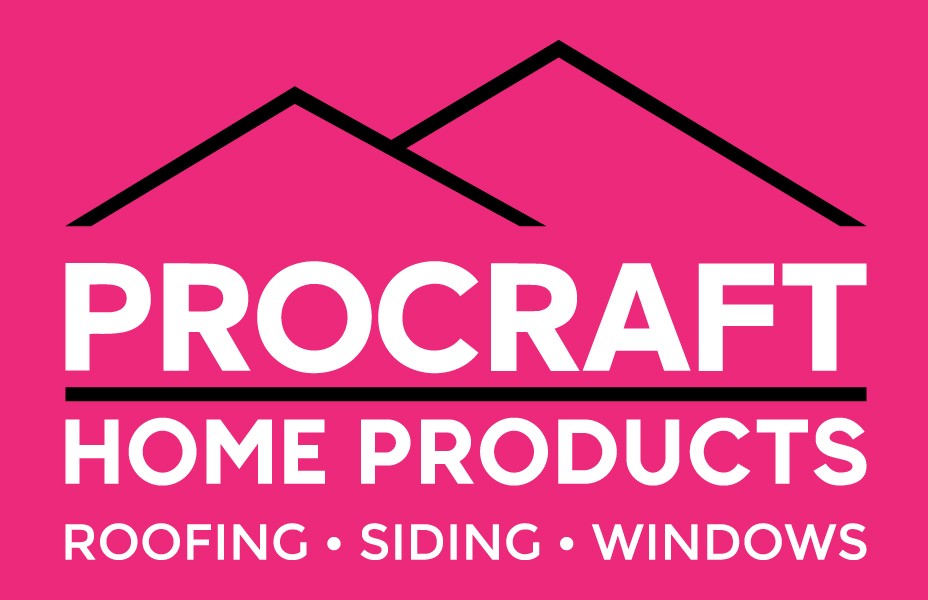Vinyl siding is a popular material used for exterior wall cladding on homes and buildings. While it does provide some insulation benefits, it is not typically considered an energy-efficient material on its own. However, there are several factors that can impact the energy efficiency of vinyl siding, including the type of insulation used behind the siding and the quality of the installation.
Why Vinyl Siding Over Others?
Vinyl siding is a popular choice for home exteriors for several reasons:
Affordability
Vinyl siding is relatively inexpensive compared to other types of siding materials like wood, brick, or stone. This makes it an attractive option for homeowners who want to improve their home’s curb appeal without breaking the bank. In terms of cost, vinyl siding is generally considered to be a more affordable option compared to other types of siding materials like wood or fiber cement. The cost of vinyl siding can vary depending on factors such as the quality of the material, the thickness and style of the siding, and the size and complexity of the installation. On average, homeowners can expect to pay between $4 and $12 per square foot for vinyl siding installation.

Durability
Vinyl siding is made from polyvinyl chloride (PVC) resin, which is a highly durable material that can withstand harsh weather conditions such as rain, wind, and extreme temperatures. It is also resistant to insect damage, rot, and fading, which means it requires less maintenance over time.
Easy to install
Vinyl siding is lightweight and easy to install, which means it can be done quickly and efficiently. This can save homeowners time and money on installation costs.
Wide range of colors and styles
Vinyl siding comes in a wide range of colors and styles, so homeowners can choose a look that suits their taste and complements their home’s architecture.
Energy efficiency
Vinyl siding can help improve a home’s energy efficiency by providing insulation that helps keep the home warm in winter and cool in summer. This can lead to lower energy bills and a more comfortable living environment.
Overall, vinyl siding is a practical and cost-effective choice for homeowners who want to improve their home’s appearance and protect it from the elements.
Ascertain The Cost Of Siding Today: Get A Professional To Know The Complexity Level Of The Installation For Your Building
Prices can vary depending on a variety of factors such as the size of the building, the type of siding material used, the complexity of the installation, and the location of the building.
To determine the cost of siding for your building, it’s best to consult with a professional contractor who can assess the complexity of the installation and provide you with an accurate estimate based on your specific needs and requirements.
Some factors that can affect the complexity of the installation include:
The size and shape of the building
A larger building or a building with complex angles and corners may require more time and effort to install siding properly.
The type of siding material
Different types of siding materials require different installation techniques and equipment, which can affect the overall cost.
The condition of the existing siding
If you’re replacing old siding, the condition of the existing siding can affect the complexity of the installation. If there’s damage or rot, additional repairs may be required before the new siding can be installed.
The location of the building
Depending on where your building is located, local building codes and regulations may affect the installation process, which can affect the overall cost.
Overall, it’s important to consult with a professional contractor to determine the cost of siding for your building, as they can assess the complexity of the installation and provide you with an accurate estimate based on your specific needs and requirements. The cost of vinyl siding installation can range from $3 to $7 per square foot for basic materials and installation, but can go up to $10 per square foot or more for higher quality materials and more complex installations.
General Estimated Costs For Popular Types Of Siding Materials
Here are some estimated costs for popular types of siding materials based on national averages:

Vinyl Siding:
Vinyl siding is a popular and durable material used for the exterior cladding of homes and other buildings. The cost of vinyl siding can vary widely depending on a number of factors, including the size of the home, the complexity of the design, and the quality of the siding itself.
On average, the cost of vinyl siding ranges from $3 to $8 per square foot installed. This means that a 2,000 square foot home could cost between $6,000 and $16,000 for vinyl siding installation.
The quality of the vinyl siding can also impact the cost. Low-quality vinyl siding may be less expensive, but it may not last as long or provide the same level of insulation as higher-quality siding.
Other factors that can affect the cost of vinyl siding installation include the removal and disposal of existing siding, the need for additional insulation or sheathing, and the complexity of the design.
Stone siding
Stone siding is a type of exterior siding that mimics the look and texture of natural stone. It is a popular choice for homeowners who want to add a touch of elegance and durability to their homes. The cost of stone siding can vary depending on several factors, including the type of stone, the size and complexity of the project, and the location of the installation.
In general, the cost of stone siding can range from $10 to $30 per square foot. This price range includes the cost of the materials, installation, and any additional services such as sealing or maintenance. Keep in mind that the cost can be higher for more complex projects or for premium types of stone such as marble or granite.
It’s important to note that while stone siding can be more expensive than other types of siding materials, it is generally considered to be a long-term investment that can add value to your home. Stone siding is durable, low-maintenance, and can improve the energy efficiency of your home by providing an extra layer of insulation.
Before deciding on stone siding, it’s a good idea to research the different types of stone available, compare prices, and consider the installation process and any additional maintenance costs. You may also want to consult with a professional contractor to get an accurate estimate of the total cost of the project.
Wood siding
Wood siding can be an attractive and durable option for exterior cladding, but the cost can vary depending on several factors such as the type of wood, the quality of the wood, the size and complexity of the project, and the region where you live.
Cedar and redwood are popular choices for wood siding due to their natural resistance to decay and insects, but they can be more expensive than other types of wood. Pine and spruce are more affordable options, but they may require more maintenance and treatment to resist decay and insects.
The quality of the wood can also affect the cost. Higher quality wood may have fewer knots and defects, which can increase the cost per board. The size and complexity of the project can also impact the cost, as larger projects and more intricate designs may require more materials and labor.
Additionally, the region where you live can affect the cost of wood siding. For example, wood may be more expensive in areas where it is not readily available, or in regions with higher labor costs.
Overall, the cost of wood siding can range from $3 to $10 per square foot, or more, depending on the factors mentioned above. It’s important to get multiple quotes from reputable contractors to ensure you’re getting a fair price for your wood siding project.
Fiber cement siding
Fiber cement siding is a type of durable exterior siding made from a mixture of cement, sand, and cellulose fibers. It has become a popular choice for homeowners because it is resistant to rot, insects, and fire, and requires little maintenance.
In terms of cost, fiber cement siding can be more expensive than traditional vinyl siding, but it is generally less expensive than natural wood or stone siding. The exact cost will depend on a variety of factors, including the size of the project, the quality of the siding, and the installation costs.
On average, the cost of fiber cement siding can range from $4 to $12 per square foot installed, with the average cost falling around $8 per square foot. This price range includes the cost of the siding materials, labor, and any necessary additional materials or equipment.
It’s important to note that while fiber cement siding may have a higher initial cost compared to other siding materials, it is typically a more cost-effective choice over the long term due to its durability and low maintenance requirements.
Brick siding
Brick siding is a popular choice for homeowners who want a durable and attractive exterior for their homes. The cost of brick siding varies depending on several factors, including the size of the house, the type of brick used, and the complexity of the installation.
In general, the cost of brick siding can range from $12 to $20 per square foot. For a typical 2,500 square foot home, this would translate to a total cost of $30,000 to $50,000. However, the final cost will depend on the specific materials and installation techniques used.
Some factors that can affect the cost of brick siding include:
Type of brick
There are many different types of brick, ranging from basic red bricks to more expensive, decorative options. The cost of the brick itself can vary greatly depending on the type and quality.
Installation
The complexity of the installation can also affect the cost of brick siding. For example, if the house has many windows or doors, or if the siding needs to be installed on multiple stories, the installation may be more time-consuming and expensive.
Additional materials
In addition to the bricks themselves, there may be additional materials needed for the installation, such as mortar, flashing, and insulation. These materials can add to the overall cost of the project.
It’s always a good idea to get a few different quotes from reputable contractors to get an idea of the cost of brick siding for your specific project.
Stucco siding
Stucco siding is a popular type of exterior siding made from a mixture of cement, sand, and water. It is known for its durability and low maintenance, and it can be a great option for homeowners looking for a long-lasting and attractive exterior for their home.
The cost of stucco siding can vary depending on several factors, including the size of the home, the complexity of the design, the quality of the stucco material, and the region in which you live. Generally speaking, the cost of stucco siding can range from $6 to $9 per square foot, including installation.
Other factors that can impact the cost of stucco siding include the need for any repairs or preparation work to the existing exterior, the cost of any permits or inspections required by your local government, and the cost of any additional features or finishes you may choose to add to your stucco siding.
It is important to get a detailed quote from a professional stucco contractor in your area to get an accurate estimate of the cost of stucco siding for your home.
Enjoy Vinyl Siding By Leveraging On The Low Maintenance & Cost Effectiveness
Vinyl siding is a popular choice for homeowners looking for an affordable and low-maintenance option for their home’s exterior. Here are some tips to leverage on the low maintenance and cost effectiveness required to enjoy vinyl siding cost:
Choose a quality vinyl siding product
Not all vinyl siding is created equal, and choosing a quality product can make a big difference in the durability and longevity of your siding. Look for a product with a good warranty and a proven track record of performance.
Proper installation is key
Vinyl siding is easy to install, but it’s important to ensure that it’s installed correctly to prevent issues down the road. Make sure you hire an experienced contractor who knows how to install vinyl siding properly.
Keep it clean
One of the great things about vinyl siding is that it requires very little maintenance. However, it’s still important to keep it clean to prevent the buildup of dirt and grime. A simple wash with a garden hose or pressure washer can do the trick.
Inspect regularly
While vinyl siding is low-maintenance, it’s still important to inspect it regularly for any damage or wear and tear. Catching issues early can save you money in the long run.
Consider the long-term savings
While vinyl siding may have a higher upfront cost than some other materials, it can save you money in the long run due to its low maintenance requirements and durability. Factor this into your decision-making process when choosing a siding material.
By following these tips, you can leverage on the low maintenance and cost effectiveness of vinyl siding to enjoy a beautiful and durable exterior for your home.
Long Lasting Use Void of Mishaps
“Long lasting use void of mishaps” is a phrase that can be interpreted as a desire for a product or system that can endure a long period of usage without any incidents or accidents occurring. Achieving this goal requires careful planning, design, and implementation of safety protocols.
To achieve long-lasting use without mishaps, it is essential to prioritize safety during the design and development stages of the product or system. This can include conducting thorough risk assessments, identifying potential hazards, and implementing safety features to mitigate those risks.
Regular maintenance and inspections are also crucial to ensuring long-lasting use void of mishaps. These activities can help identify and address any potential issues before they become major problems, reducing the risk of accidents or incidents occurring.

Product's All-round Versatility
Vinyl siding is a popular choice for home exteriors due to its versatility, durability, and affordability. It is made from polyvinyl chloride (PVC) and comes in a variety of colors, textures, and styles to suit different architectural designs.
One of the biggest advantages of vinyl siding is its low cost compared to other siding materials such as wood or brick. It is also easy to install and requires minimal maintenance, making it a cost-effective choice for homeowners.
In addition to its affordability, vinyl siding is also versatile in terms of its design and appearance. It can mimic the look of other materials such as wood, stone, or brick, giving homeowners a wide range of options to choose from. It is also available in a variety of colors, allowing homeowners to match the siding with their home’s existing color scheme.
Vinyl siding is also durable and resistant to weather, including wind, rain, and snow. It is also resistant to fading, cracking, and warping, which means it can maintain its appearance and structural integrity for many years with minimal maintenance.
Overall, vinyl siding offers a cost-effective and versatile option for homeowners who want to improve the appearance and durability of their home’s exterior.
Additionally, providing adequate training and education to users of the product or system is essential. This can include instruction on safe operation, maintenance, and emergency procedures, as well as providing warnings and guidelines for safe use.
Ultimately, achieving long-lasting use without mishaps requires a holistic approach that prioritizes safety at every stage of the product or system’s life cycle. By taking a proactive approach to safety, it is possible to minimize the risk of accidents or incidents occurring and ensure that the product or system can be used safely and effectively for an extended period.
In Summary
If energy efficiency is a priority for your home, it may be worth investing in additional insulation measures such as adding insulation to the walls or upgrading windows and doors. While these measures may increase the upfront cost of your home renovation project, they can provide long-term energy savings and help reduce your carbon footprint. It’s important to work with a reputable contractor who can help you determine the best options for your specific home and budget.
Frequently Asked Questions
Yes, vinyl siding is generally the most affordable option compared to other materials like wood, brick, or stone. It is also easy to install and requires minimal maintenance, making it a cost-effective choice for homeowners.
Vinyl siding does not provide significant insulation benefits on its own, but it can help reduce air infiltration. For increased energy efficiency, additional insulation measures such as adding insulation to the walls or upgrading windows and doors may be necessary.
The average cost of vinyl siding for a 2,000 square foot home is around $6,000 – $16,000. The total cost can vary depending on factors such as the type and quality of material used and labor costs.
For a 1000 square feet house wall surface area, the cost of vinyl siding can range from $3,000 to $8,000. The total cost will depend on factors such as quality and type of material used, labor costs and other additional costs associated with installation.
Because insulated vinyl siding helps reduce air infiltration, it can make your home more energy efficient and help you save money on energy costs. Additionally, insulated vinyl siding may provide additional structural support for your home and make it more resilient to extreme weather conditions.
Vinyl siding generally has a lifespan of 20-40 years, depending on the quality of material used and how well it is maintained. With proper maintenance and care, vinyl siding can last beyond 40 years.
While we do not recommend installing vinyl siding yourself due to the complexity of the process, it is possible to do so with the right tools and guidance. Before you attempt this project, make sure you research the process thoroughly or consult a professional for help. Additionally, check local building codes to see if there are any restrictions on DIY projects before starting your installation.
Yes, Tyvek is generally recommended as a moisture barrier under vinyl siding. It helps protect the walls and insulation from water damage and can also help reduce air infiltration. Tyvek should be installed with the appropriate nails or staples to ensure it will remain securely in place.
